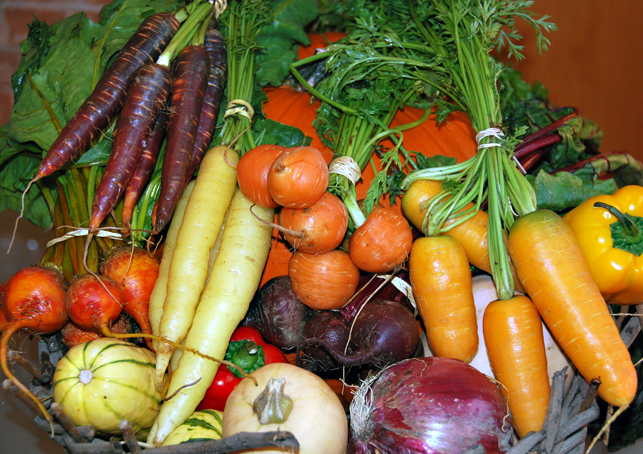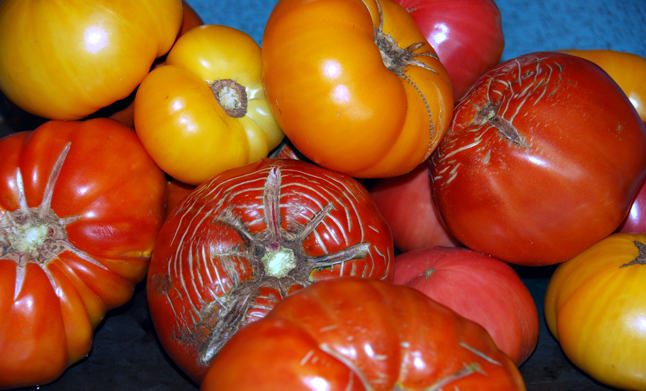

Vegetable comes from the Latin vegetabilis meaning animated, vegetare meaning enliven, and vegetus, meaning active. These Latin terms come from the Indo-European base weg, (giving us the English wake) meaning become or stay alert. (Wikipedia.)
You have to love it. The history symbolizes the way real food advocates think about veggies: food that’s alive, life-forces flying to your body, energizing you with enzymes, minerals and vitamins. Never mind that children today photosynthesize energy out of micro-screens and pop-cans — eventually they will eat their broccoli. (One of my daughters lived on rice, eggs and fruit until the age of 12. Her children, however, eat salmon roe and sushi with gusto.)
At Umberto’s at Whistler, I was served one of the loveliest meals of my life—a small piece of fish was accompanied by NINE vegetables on the plate, only one of them starchy. Every one was cooked in a different way. It was amazing.
Discussion about food sourcing ends up one place: local veggies are the best bet. Never in my lifetime has food garnered so much media attention. I don’t mean Chatelaine and Good Housekeeping, but mainstream papers such as The Globe and Mail, as well as The Tyee, the on-line news screen out of Vancouver. The Globe focus this whole week is to be on food, starting with a discussion of food safety in a global food market, and how iffy it is. See http://www.theglobeandmail.com/news/national/time-to-lead/global-food/. And The Tyee continues its ongoing focus on food sourcing in BC. See http://thetyee.ca/Topic/Food/.
We should be researching food sources with the obsession we put into other consumer expenditures, say cars, or sports. The amount of foodstuff coming into Canada without safety documentation has risen hugely in the past ten years. As one who lived in China at the end of the melamine-milk scandal that resulted in execution for one Chinese milk producer official, I can tell you that this is scarey. The laws in China astonishingly permit a certain amount of melamine in milk (the offenders went over the limit). Once the scare was supposedly over, the supermarkets posted hand-penned signs saying Milk Is Safe. “Aha,” said our friend the retired Professor, “Don’t believe a word of it, my government lies!” Right.
So to Real Food—food that doesn’t come from a factory but from a farm. We are lucky to have the fruits of autumn harvests of locally grown vegetables. In the case of Wild Flight Farms, these are available to us all winter long, via the Community Markets held every other Thursday at the Revelstoke Community Centre. (See companion listing for dates.)
But some vegetables are intimidating. Wildflight Farm’s newsletter (you can subscribe for free at http://www.wildflightfarm.ca/ ) does a lot to mitigate fear of the vegetable, with weekly recipes for tatsoi and black kale and other “new” veggies. And cookbooks such as Moosewood and Hollyhock Cooks have introduced a generation of young cooks to new approaches to what we used to call poison balls (guess!)
My editor reminds me that lots of young people in our community move out from Mom and Pop’s place with nary a notion about how to boil an egg let alone a rutabaga or the astonishing cauliflower varietal in the photo (the green thing that looks like the eyeball of a Martian dinosaur), so I thought a primer on veggies might not go amiss. If you’re an experienced cook, skip the next paragraphs.
Buying and storing vegetables
Buy the best. Veggies that look tired probably are. Avoid bruises when possible. Buy vegetables with the skins on: like yours, the skin keeps microbes out and goodness in. Don’t peel a veg or wash it until you’re going to use it. The exception is obvious mud or dirt on leaves or stalks: brush or shake it off. If you do have to clean the vegetable, dry it well after washing and wrap in tea towels, unbleached paper towel or waxed paper before storing it. (A friend once gave me a terry-towel veggie drawstring bag — wonderful thing.) Here’s how to store most veg:
• Potatoes and onions in paper or cloth, in a cool, dry dark place (not the fridge.)
• Most other veg in perforated plastic or cloth bags, or wrapped in paper towel, in the fridge.
• Leafy greens, including tops of root vegetables, in paper or cloth then in perforated plastic bags, in the fridge crisper.
• Mushrooms in brown paper bags.
• Hard squash, onions, garlic, cool but not refrigerated.
• Tomatoes: let them ripen out of the fridge, but put them in to store more than a few days.
Cleaning vegetables
Essential. Nothing worse than sand in the mouth. And just last week I found a little worm in a bag of corn salad, so yes I wash even the stuff that looks or says “pre-washed.” Use a brush and running water. Wash supermarket lettuce in hot water then rinse in cold.
Cooking vegetables
Some people object to microwaving vegetables. There is some evidence that no nutrients are lost in microwaving, and that the shorter cooking time of the microwave actually preserves more food value than regular cooking. But other reports show that microwaved frozen breast milk shows a significant loss of nutrient. My take on this is that we need more research, so in the mean time, occasionally microwaving food is okay, but I try not to make it a regular practice — except for milk for café au lait in the morning.
Boiling
Years ago, vegetables were boiled. Period. Yecch, in general. Why pour half the nutrients down the drain? However, boiling non-greens — potatoes, beets, carrots (sometimes), corn, squash, turnip, rutabaga, peas and beans is often a first and sometimes the simplest method of cooking vegetables. With butter or oil and a little salt an pepper, almost any vegetable can be cooked in a pot of boiling water until a test taste tells you it’s ready to eat. Boiling large veg such as potatoes is faster if you cut them up. I think you have to boil a turnip.
Steaming
A steamer prevents the loss of food value into a potful of water, and is often the most economical and low-cal method of cooking vegetables. However, bland mealy veg such as potatoes or squash can be mushy when steamed. Great for cauliflower or broccoli.
Grilling
Many vegetables, from eggplant to lettuce, including potatoes, sweet potatoes, squash, sprouts, tomatoes, asparagus, parsnip, peppers, mushrooms, are very nice grilled, either on the BBQ or in a very hot (425 – 450) oven. Cut into large bite-size pieces and toss with olive oil and a little pepper (not salt) and a squirt of balsamic if you like, and put onto a flat baking sheet with low sides. Timing depends on the vegetable, but try 5 minutes for lettuce, 10 for other leafy greens, 15 for tomatoes, zucchini, mushrooms or peppers, 20 for brussel sprouts and asparagus, and 30 for potatoes and squash. Cooking times will vary depending on oven temp, the amount of moisture in the vegetables, and the size of your pieces. I set a timer for the minimum time, and add 5 minute increments after that. Put course sea salt on AFTER the veg are cooked — it you do it before, the salt draws moisture out of the veg and they will taste less succulent.
If you’re short of time but want to grill potatoes or squash, parboil them first, while the oven heats up. Then drain, toss with oil, and grill as above.
Braise and glaze
Prep root veg or fennel, celery, peppers, tomatoes as for grilling. Set the oven at 350 to 375. Make a mixture of
1 cup water or stock, or white wine for fennel, red wine for peppers and tomatoes
2-6 tbsp butter
1 tsp sugar
½ tsp salt
1 tbsp balsamic vinegar
Put the vegetables into a shall sided flat baking pan with the braise’n’glaze liquid. Cover loosely with tin foil and bake for 45-60 minutes. Remove cover for last 15 minutes of cooking. Check every so often to ensure liquid has not entirely disappeared. It will evaporate by the time the veg are cooked, leaving a lovely glaze. Fennel is particularly nice done this way, with just white wine and butter, but large imported fennel may require 90 minutes in a slow oven, covered loosely with foil for the first hour.
Sauté or frying
The fast easy route to cooking onions, garlic, peppers, tomatoes, mushrooms, zucchini, diced squash, diced potatoes, –well, diced anything. You put a little oil or butter in a frying pan, or a little water if that’s your thing, turn on the heat and stand there. Turn everything over every few minutes. Add water, 1 tbsp. at a time, if things seem to be getting too brown. (This is the line cooks’ sauté method — watch’em sometime cooking bacon. It causes lots of sputtering and steam, which hastens the cooking.)
Deep frying
Using a tempura batter is one way to do this. Beer batter is good. The trick is to keep the oil at a constant temperature of 365, which is tricky because every time you add more to the pot of boiling oil, the temperature falls. A deep fat fryer is a boon if you really like fried food, but generally most of us are trying to avoid fried stuff these days, except for special occasions or a trip out for French Fries. ANY vegetable can be chopped up or julienned into a batter and deep fried; potatoes go in without batter; sweet potato fries are the latest scrumptious restaurant appie — what a killer! they are sooo good.
Stir frying
Again, any veggie or veggie mixture can be stir fried if you have a wok or even a frying pan. Start with those that take the longest cooking time. Cut up the vegetables into fairly small pieces, especially if you are using potato, turnip, squash, parsnip or carrots. The secret is to get a little (1-2 tbsp) oil in the pan sizzling hot, then add veg and keep stirring. Add a mixture of
½ to ¾ cup water or white wine
2-3 tbsp flavoured sauce such as Hoisin, soy or Black bean
1 tbsp Maletti Baslamic vinegar, or other flavoured balsamic to taste. Star Apple is spectacular .
chopped garlic
1 tbsp cornflour, mixed thoroughly into 1 tbsp of the sauce then re-introduced to the pan
Keep stirring. If you are adding greens or bean sprouts, chop greens into ribbons and add 1-2 minutes before you are sitting down to eat.
Serving vegetables
Keep the ketchup in the fridge, and try garnishing vegetables with
• a drizzle of olive oil and good balsamic, plus sea salt and pepper
• feta cheese crumbled
• pine nuts, toasted lightly; slivered almonds; chopped hazelnuts or walnuts
• raisins, dried cranberries or slivered dried apricots
• butter and lemon juice
Experiment, and enjoy the fruits of the earth.




